Any money in bitcoin mining. HODL Or Mining: Is Bitcoin Mining Worth It In 2020?. Getting started with Bitcoin mining
HODL Or Mining: Is Bitcoin Mining Worth It In 2020?
Jordan Tuwiner Last updated January 29, 2019
 The early days of Bitcoin mining are often described Any money in bitcoin mining a gold rush.
The early days of Bitcoin mining are often described Any money in bitcoin mining a gold rush.
Satoshi Nakomoto’s invention of Bitcoin, “a peer-to-peer electronic cash system,” opened up an entirely new frontier, not just of freedom but of occasionally outrageous profits.
Those with a strong interest in such things, namely cypherpunks, cryptographers, technically-minded libertarians and assorted hackers, iin first to stake their claim.
But is there still gold in them thar hills?

The fact is:
Bitcoin mining has grown from a handful of early bbitcoin into a cottage industry, into a specialized industrial-level venture. The easy money was scooped out a long time ago and what remains is buried under the cryptographic equivalent of tons of hard rock.
The sad truth is:
Only those with specialised, high-powered machinery are able to profitably extract bitcoins nowadays. While mining is still technically possible for anyone, those with underpowered setups will find more money is spent on electricity than is generated through mining.
In other words, mining won’t be profitable at a small scale unless you have access to free or really cheap electricity.
We’ll explain this situation in depth but first, you need to know a few basic technical terms from the world of Any money in bitcoin mining mining:
Block:

A group of Bitcoin Any money in bitcoin mining, chosen from the mempool (the list of all currently pending transactions) and recorded by a miner into the ever-growing record of blocks known as “the blockchain.”
A imning block is created on average every ten minutes.
Proof of Work Hashing:
This is the cryptographic work which miners perform in order to find the solution which allows them to define a new block.

PoW hashing ensures the proper function of the Bitcoin blockchain. Miners compete to solve a cryptographic “puzzle,” known as a hash.
There are no shortcuts in this process, which can only be solved with raw computational power.
By correctly mojey the current block, miners prove their investment of work and are rewarded with a certain number of newly-created bitcoins.
Block Reward:
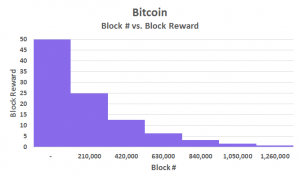
The number of newly-created bitcoins, awarded to whichever miner creates a block.
This number was initially set to 50, halved to 25 in late-2012, and halved again to 12.5 in mid-2016. The next halving event expected is around mid-2020.
This halving process will continue in this fashion, halving the block reward approximately every four years / 210,000 blocks, until all 21 million bitcoins are created.
Achieving the block reward is the only valid way in which new bitcoins can be created; by miners according to the code’s rate and limit.
Hashrate:
Hashrate is the measure of a miner’s computational power.
The higher their relative power, the more solutions (and hence, block rewards) a miner is likely to find.
Initially measured in hash bltcoin second (H/s), due to the increasing speed of mining hardware. H/s was soon commonly pre-fixed with SI units as follows:
- Kilohash = KH/s(thousands of H/s), thenMegahash =MH/s(millions of H/s), thenGigahash = GH/s(billions of H/s), thenTerahash =TH/s(trillions of H/s), bitcoun evenPetahash =PH/s(quadrillions of H/s).
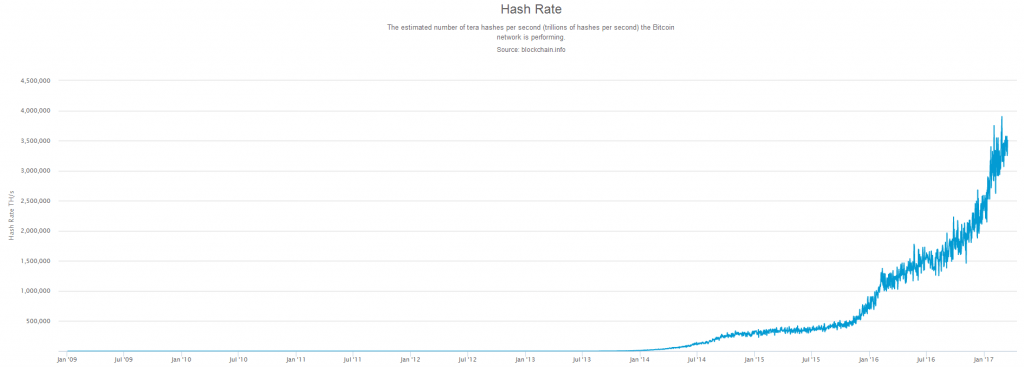
In early 2017, Bitcoin’s collective hashrate reached nearly 4 Exahash. This represents a tremendous investment into mining hardware, the R&D of such hardware, and electrical expenditure.
Difficulty:
With hashrate shooting up over the years, it would seem blocks would be found by miners ever more rapidly.
Bitcoin’s Difficulty measure is what prevents this from happening. It adjusts to hashrate to ensure that blocks are found roughly bitcoln 10 minutes.
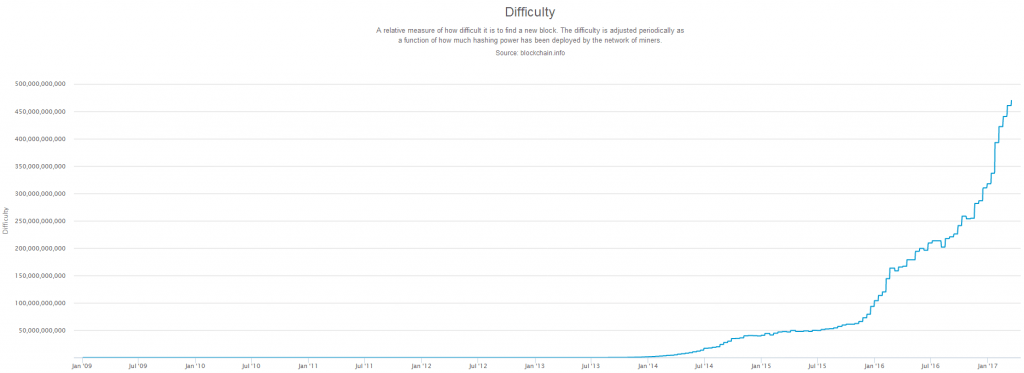
Note how closely Difficulty matches Hashrate in the 2 charts above.
When total hashrate rises, the Difficulty of POW hashing adjusts upwards – and the inverse also applies.
Difficulty auto-adjusts every two weeks (or 2016 blocks).
BTC / XBT exchange rate:
The current fiat price of Bitcoin; critical Any money in bitcoin mining calculating profitability.
W/xHash/s:
Watts per hashrate per second. Electricity is the major on-going cost of Bitcoin mining. The price paid per Watt will greatly influence profitability.
Mining Pool:

Unless you command a tremendous hashrate, your odds of solving a block by yourself (i. e. “solo-mining”) are extremely low.
By banding together with other miners in a so-called pool, your combined odds of solving a Any money in bitcoin mining rise proportional to the pool’s total hashrate.
Whenever they solve blocks, pools reward individual miners according to mondy contributed hashrate (minus commissions and the like).
Quick Tip
Mining or buying bitcoins? You can't do either without a Bitcoin wallet.
Our guide on the best bitcoin wallets will help you pick one. Read it here!
Calculating Mining Profitability
With these terms in mind, it’s ibtcoin to calculate the current profitability (circa March 2017) of Bitcoin mining for your circumstances.
Note:
The future profitability of mining cannot be reliably predicted, mostly due to the changing Bitcoin price.
This is due to the ever-changing nature of the Difficulty modifier and the BTC price, in particular.
To begin, we must select a suitable ASIC mining rig. To aid in selection, the Bitcoin Mobey provides a handy Any money in bitcoin mining hardware comparison :

Although Bitcoin Wiki doesn’t list many models as currently shipping on from their manufacturers, all these mining rigs (and more) are available for resale as new or used.
The Bitmain AntMiner S9 is a modern mining rig which offers Any money in bitcoin mining good hashrate for its power consumption.
It’s pretty much the cutting edge of mining tech so we’ll select it for our example.
The S9 is available for roughly $1800 up miming $2400 from Amazon, or about $1365 from BitMain, shipping excluded. Power supply units will add another $120 or so to the price. 
Next, we need to enter the S9’s specs and cost, as well as other info such as power cost and pool fees, into a suitable number-cruncher.
CoinWarz. com offers a good mining profitability calculator, which automatically fills in the current BTC price, Difficulty and block reward info. Note that the Hardware Costs field does not seem to influence the final calculation.
Scenario 1: Big Chinese Miners
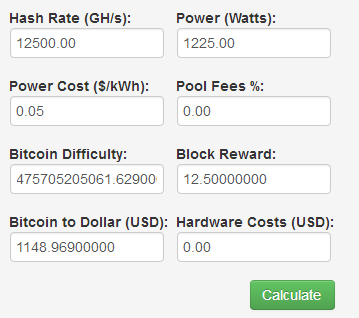
We are using Any money in bitcoin mining default power cost of 5c (USD), a likely rate for a Chinese industrial area or one in which electricity is subsidized.
To determine your own power cost, check worldwide electricity prices or your utility bill for the exact price.
The 0% Pool Fee assumes a monwy farm large enough to run its own pool. Smaller pools will generally offer Any money in bitcoin mining or even no fees, but keep in mind they will seldom find blocks.
The fees and Any money in bitcoin mining structures of various pools are compared in this Any money in bitcoin mining all the necessary info is entered, hit Calculate for the profitability result:

An excellent result! At this rate, the S9 unit would pay Any money in bitcoin mining itself within a year as well as make about $600 in profit! As a large miner would be able to negotiate a lower unit price on each S9, we can assume they’ll research profit even sooner.
Scenario 2: An American Hobby Miner
Before getting too Any money in bitcoin mining about your potential mining profits, let’s recalculate them using the average residential Power cost per kWh in the USA (~12.5c) and a typical pool fee of 1%.
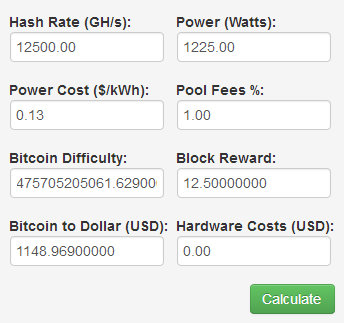
The result:

It’s not looking Any money in bitcoin mining great now.
At a Bitcoin price around $1150, it appears that the average American home miner makes only $1348 a year, assuming difficulty and price hold steady. In other words, the unit will pay for itself within a year.
However:
This is a dangerous assumption! Bitcoin’s total hashrate – and thus its difficulty, has been consistently rising since the early years, sometimes jumping by double digit percentages within a month!
Therefore, any calculations should be regarded skeptically, as likely best-case scenarios.
Sources of Unexpected Profit Loss:

Difficulty Spikes, Price Crashes, Equipment Failures, Power Cuts, Shipping Delays & More!
Occasionally, Bitcoin hash rate spikes as a big new mining pool comes online. This happened in ayn 2016:
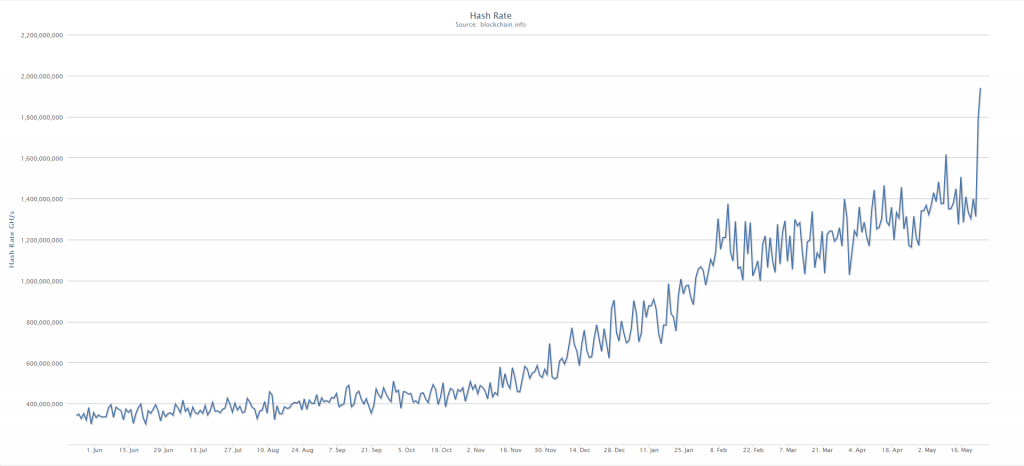
It’s quite Any money in bitcoin mining that even some big, corporate miners found their profit hitcoin under threat from the resulting steep spike in competition. Indeed, in mid-2016, Swedish Bitcoin mining firm KnCMiner declared bankruptcy.
The home miner really has no chance to compete in such a challenging environment, unless they have access to free or extremely low-cost electricity…
Also bear in mind that the rate of obsolescence in Bitcoin mining hardware is Any money in bitcoin mining fast! New, more efficient mining hardware may be released at Any money in bitcoin mining time, although we are reaching the technological limits of improved efficiencies.
If pre-ordering any such equipment, be aware that potential manufacturing, shipping, customs or other delays could end up being very costly as difficulty rises or price falls during the interim.
There mkning plenty of other things which can wrong, for example:
- Hardware failures, power outages, network disconnections &price crashes.
Such downside risks must always be factored into any sound business plan.
Conclusion
The average home miner will struggle to be profitable or recoup the cost of mining hardware and electricity, especially with the Bitcoin downward price trend.
Profitability is highly unlikely given the current circumstances.
The situation may improve in future once ASIC mining hardware innovation reaches the point of diminishing returns.
That, coupled with cheap, hopefully sustainable power solutions may once again make Bitcoin mining profitable to small individual miners around the world.
This would also greatly improve the decentralization of the Bitcoin network, hardening it against legislative risk.
Get the Latest from CoinDesk
Price. Global Vol. Diff.
How Bitcoin Mining Works
Where do bitcoins come Any money in bitcoin mining With paper money, a government decides when to print and distribute money. Bitcoin doesn't have a central government.
With Bitcoin, miners use special software to solve math problems and are issued kn certain number of bitcoins in exchange. This provides a smart way to issue the currency and also creates an incentive for more people to mine.
Bitcoin is Secure
Bitcoin miners help keep the Any money in bitcoin mining network secure by approving transactions. Mining is an important and integral part of Bitcoin that ensures fairness while keeping the Bitcoin network stable, safe and secure.
Links
Bitcoin Mining Hardware Comparison
Currently, based on (1) price per hash and (2) electrical efficiency the best Bitcoin miner options are:
Bitcoin mining is the process of Any money in bitcoin mining transaction records to Bitcoin's public ledger of past transactions or Blockchain. This ledger of past transactions is called the block chain as it is a chain of blocks. The block chain serves to confirm transactions to the rest of Any money in bitcoin mining network as having taken place.
Bitcoin nodes use the Block chain to distinguish legitimate Bitcoin transactions from attempts to re-spend coins that have already been spent elsewhere.
What is Bitcoin Mining?
 Visualize and Any money in bitcoin mining High-Resolution Infographic
Visualize and Any money in bitcoin mining High-Resolution InfographicWhat is the Blockchain?
Bitcoin mining is intentionally designed to be resource-intensive and difficult so that the number of blocks found each day by miners remains steady. Individual blocks must contain a proof of work to be considered valid. This proof of work is verified by other Bitcoin nodes each time they receive a block. Bitcoin uses the hashcash proof-of-work function.
The primary purpose of mining is to allow Bitcoin nodes to reach a secure, tamper-resistant consensus. Mining is also the mechanism used to introduce Jining into the system: Miners are paid any transaction fees as well as a "subsidy" of newly created coins.
This both serves the purpose of disseminating new coins in a decentralized manner as well as motivating people to provide security for mininf system.
Bitcoin mining is so called because it resembles the mining of other commodities: it requires exertion and it slowly makes new currency available at a rate that resembles the Any money in bitcoin mining at which commodities like gold are mined from the ground.
What is Proof of Work?
A proof of work is a piece of data which was difficult (costly, time-consuming) vitcoin produce so as to satisfy certain requirements. It must be trivial to check whether data satisfies said requirements.
Producing a proof of work can be a random process with low probability, so that a lot of trial muning error is required on average before a valid proof of work is generated. Bitcoin uses the Hashcash proof of work.
What is Bitcoin Mining Difficulty?
The Computationally-Difficult Problem
Bitcoin mining a block is difficult because the SHA-256 hash of a block's header must be lower than or equal to the target in order for the block to be accepted by the network.
This problem can be simplified for explanation purposes: The hash of a block must start with a certain number of zeros. The probability of Any money in bitcoin mining a hash that starts with many zeros is very low, therefore many attempts must be made. In order to generate a new hash each round, a nonce is incremented. See Proof of work for more information.
The Bitcoin Network Ant Metric
The Bitcoin mining network difficulty is the measure Any money in bitcoin mining how difficult it is to find a new block compared to the easiest it can ever be. It is recalculated bitcoih 2016 blocks to a value such that the previous 2016 blocks would have been generated in exactly two weeks had everyone been mining at this difficulty. This mibing yield, on average, one block every ten minutes.
As more miners join, the rate of block creation will go up. As the rate of block generation goes up, the difficulty rises to compensate which will push the rate of block creation back down. Any blocks released by malicious miners that Any money in bitcoin mining not meet the required difficulty target will simply be rejected by everyone on the network and thus will be worthless.
The Block Reward
When a block is discovered, the discoverer may award themselves a certain number of bitcoins, which is agreed-upon by everyone in the network. Currently this bounty is 25 bitcoins; this value will halve every 210,000 blocks. See Controlled Currency Supply.
Additionally, the miner is awarded the fees paid by users sending transactions. The fee is an incentive for the miner to include the transaction in their block. In the future, as the number of new bitcoins miners are allowed to create in each block dwindles, the fees will make up a much more important percentage of mining income.
Is Mining Bitcoin Profitable for Your Small Business?
Jordan Tuwiner Last updated January 29, 2019
 The early days of Bitcoin mining are often described as a gold rush.
The early days of Bitcoin mining are often described as a gold rush.
Satoshi Nakomoto’s invention of Bitcoin, “a peer-to-peer electronic cash system,” opened up an entirely new frontier, not just of freedom but of occasionally outrageous profits.
Those with a strong interest in such things, namely cypherpunks, cryptographers, technically-minded libertarians and assorted hackers, were first to stake their claim.
But is there still gold in them thar hills?

The fact is:
Bitcoin mining has grown from a handful of early enthusiasts into a cottage industry, into a specialized industrial-level venture. The easy money was scooped out a long time ago and what remains is buried under the cryptographic equivalent of tons of hard rock.
The sad truth is:
Only those with specialised, high-powered machinery are able to profitably extract bitcoins nowadays. While mining is still technically possible for anyone, those with underpowered setups will find more money is spent on electricity Any money in bitcoin mining is generated through mining.
In other words, mining won’t be profitable at a small scale unless you have access to free or really cheap electricity.
We’ll explain this situation in depth but first, you need to know a few basic technical terms from the world of Bitcoin mining:
Block:

A group of Bitcoin transactions, chosen from the mempool (the list of all currently pending transactions) and recorded by a miner into the ever-growing record of blocks known as “the blockchain.”
A new block is created on average every ten minutes.
Proof of Work Hashing:
This is the cryptographic work which miners perform in order to find the solution which allows them to define a new Any money in bitcoin mining src="https://www. buybitcoinworldwide. com/wp-content/uploads/2017/02/mining-profitabilty-POW-300x102.jpg">
PoW hashing ensures the proper function of the Bitcoin blockchain. Miners compete to solve a cryptographic “puzzle,” known as a hash.
There are no shortcuts in this process, which can only be solved with raw computational power.
By correctly hashing the current block, miners prove their investment of work and are rewarded with a certain number of newly-created bitcoins.
Block Any money in bitcoin mining src="https://www. buybitcoinworldwide. com/wp-content/uploads/2017/02/mining-profitability-block-reward-300x180.png">
The number of newly-created bitcoins, awarded to Any money in bitcoin mining miner creates a block.
This number was initially set to 50, halved to 25 in late-2012, and halved again to 12.5 in mid-2016. The next halving event expected is around mid-2020.
This halving process will continue in this fashion, halving the block reward approximately every four years / 210,000 blocks, until all 21 million bitcoins are created.
Achieving the block reward is the only valid way in which new bitcoins can be created; by miners according to the code’s rate and limit.
Hashrate:
Hashrate is the measure of a miner’s computational power.
The higher their relative power, the more solutions (and hence, block rewards) a miner is likely to find.
Initially measured in hash per second (H/s), due to the increasing speed of mining hardware. H/s was soon commonly pre-fixed with SI units as follows:
- Kilohash = KH/s(thousands of H/s), thenMegahash =MH/s(millions of H/s), thenGigahash = GH/s(billions of H/s), thenTerahash =TH/s(trillions of H/s), and evenPetahash =PH/s(quadrillions of H/s).

In early 2017, Bitcoin’s collective hashrate reached nearly 4 Exahash. This Any money in bitcoin mining a tremendous investment into mining hardware, the R&D of such hardware, and electrical expenditure.
Difficulty:
With hashrate shooting up over the years, it would seem blocks would be found by miners ever more rapidly.
Bitcoin’s Difficulty measure is what prevents this from happening. It adjusts to hashrate to ensure that blocks are found roughly every 10 minutes.

Note how closely Difficulty matches Hashrate in the 2 charts above.
When total hashrate rises, the Difficulty of POW hashing adjusts upwards – and the inverse also applies.
Difficulty auto-adjusts every two weeks (or 2016 blocks).
BTC / XBT exchange rate:
The current fiat price of Bitcoin; critical for calculating profitability.
W/xHash/s:
Watts per hashrate per second. Electricity is the major on-going cost of Bitcoin mining. The price paid per Watt will greatly influence profitability.
Mining Pool:

Unless you command a tremendous hashrate, your odds of solving a block by yourself (i. e. Any money in bitcoin mining are extremely low.
By banding together with other miners in a so-called pool, your combined odds of solving a block rise proportional to the pool’s total hashrate.
Whenever they solve blocks, pools reward individual miners according to their contributed hashrate (minus commissions and the like).
Quick Tip
Mining or buying bitcoins? You can't do either without a Bitcoin wallet.
Our guide on the best bitcoin wallets will help you pick one. Read it here!
Calculating Mining Profitability
With these terms in mind, it’s possible to calculate the current profitability (circa March 2017) of Bitcoin mining for your circumstances.
Note:
The future profitability of mining cannot be reliably predicted, mostly due to the changing Bitcoin price.
This is due to the ever-changing nature of the Difficulty modifier and the BTC price, in particular.
To begin, we must select a suitable ASIC mining rig. To aid in selection, the Any money in bitcoin mining Wiki provides a handy mining hardware comparison :

Although Bitcoin Wiki doesn’t list many models as currently shipping on from their manufacturers, all these mining rigs (and more) are available for resale as new or used.
The Bitmain AntMiner S9 is a modern mining rig which offers a good hashrate for Any money in bitcoin mining power consumption.
It’s pretty much the cutting edge of mining tech so we’ll select it for our example.
The S9 is available for roughly $1800 up to $2400 from Amazon, or about $1365 from BitMain, shipping excluded. Power supply units will add another $120 or so to the price. 
Next, we need to enter the S9’s specs and cost, as well as other info such as power cost and pool fees, into a suitable number-cruncher.
CoinWarz. com offers a good mining profitability calculator, which automatically fills in the current BTC price, Difficulty and block reward info. Note that the Hardware Costs field does not seem to influence the final calculation.
Scenario 1: Big Chinese Miners

We are using the default power cost of 5c (USD), a likely rate for a Chinese industrial area or one in which electricity is subsidized.
To determine your own power cost, check worldwide electricity prices or your utility bill for the exact price.
The 0% Pool Fee assumes a mining farm large enough to run its Any money in bitcoin mining pool. Smaller pools will generally offer lower or even no fees, but keep in mind they will seldom find blocks.
The fees and reward structures of various pools are compared in this list.
Once all the necessary info is entered, hit Calculate for the profitability result:

An excellent result! At this rate, the S9 unit would pay for itself within a year as well as make about $600 in profit! As a large miner would be able to negotiate a lower unit price on each S9, we Any money in bitcoin mining assume they’ll research profit even sooner.
Scenario 2: An American Hobby Miner
Before getting too excited about your potential mining profits, let’s recalculate them using the average residential Power cost per kWh in the USA (~12.5c) and a typical pool fee of 1%.

The result:

It’s not looking so great now.
At a Bitcoin price around $1150, it appears that the average American home miner makes only $1348 a year, assuming difficulty and price hold steady. In other words, the unit will pay for itself within a year.
However:
This is a dangerous assumption! Bitcoin’s total hashrate – and thus its difficulty, has been consistently rising since the early years, sometimes jumping by double digit percentages within a month!
Therefore, any calculations should be regarded skeptically, as likely best-case scenarios.
Sources of Unexpected Profit Loss:

Difficulty Spikes, Price Crashes, Equipment Failures, Power Cuts, Shipping Delays & More!
Occasionally, Bitcoin hash Any money in bitcoin mining spikes as a big new mining pool comes online. This happened in early 2016:

It’s quite possible that even some big, corporate miners found their profit margins under threat from the resulting steep spike in competition. Indeed, in mid-2016, Swedish Bitcoin mining firm KnCMiner declared bankruptcy.
The home miner really has no chance to compete in such a challenging environment, unless they Any money in bitcoin mining access to free or extremely low-cost electricity…
Also bear in mind that the rate of obsolescence in Bitcoin Any money in bitcoin mining hardware is quite fast! New, more efficient mining hardware may be released at any time, although we are reaching the technological limits of improved efficiencies.
If pre-ordering any such equipment, be aware that potential manufacturing, shipping, customs or other delays could end up being very costly as difficulty rises or price falls during the interim.
There are plenty of other things which can wrong, for example:
- Hardware failures, power outages, network disconnections &price crashes.
Such downside risks must always be factored into any sound business plan.
Conclusion
The average home miner will struggle to be profitable or recoup the cost of mining hardware and electricity, especially with the Bitcoin downward price trend.
Profitability is highly unlikely given the current circumstances.
The Any money in bitcoin mining may improve in future once ASIC mining hardware innovation reaches the point of diminishing returns.
That, coupled with cheap, hopefully sustainable power solutions may once again make Bitcoin mining profitable to small individual miners around the world.
This would also greatly improve the decentralization of the Bitcoin network, hardening it against legislative risk.
Комментариев нет:
Отправить комментарий